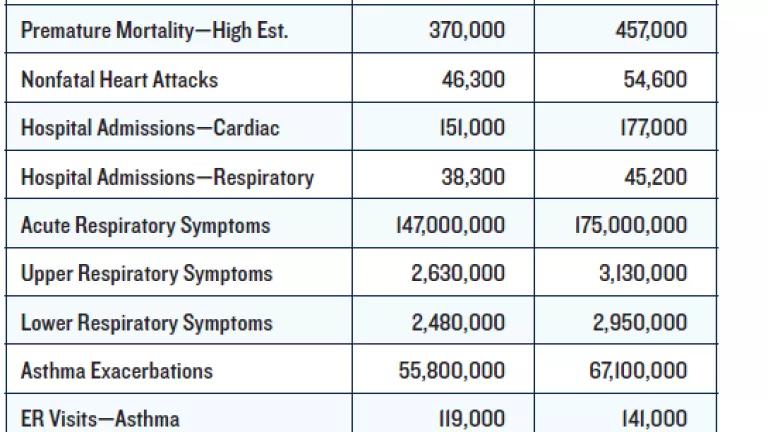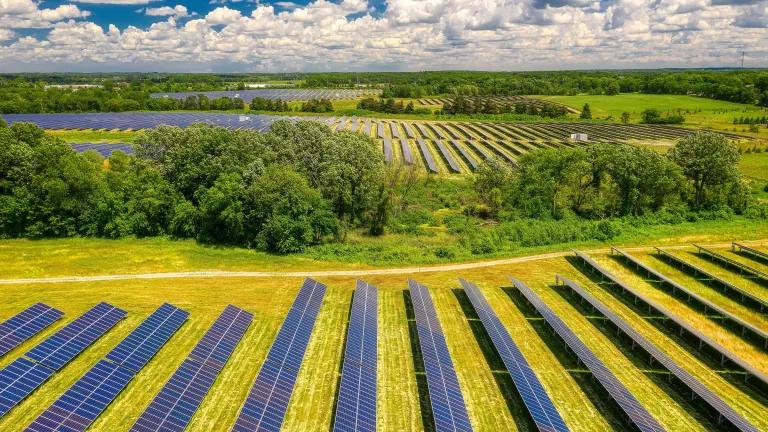NRDC Sues FERC Over Orders that Threaten NY Clean Energy
The FERC orders undermine New York’s State efforts to achieve landmark clean energy targets and also compromise efforts to replace dirty peaker plants in New York City with renewable energy and battery storage solutions, which is vitally important for reducing the disproportionate health impacts in communities of color where these peaker plants are located.

Figure 12: Production of In-State Renewables & Zero-Emission Resources Relative to 2019 Load
NRDC is suing the Federal Energy Regulatory Commission (FERC) in federal court to overturn two FERC orders that thwart New York’s development of clean energy: an order targeting storage and an order targeting demand response resources. These FERC orders undermine New York’s State efforts to achieve the landmark clean energy targets set forth in the Climate Leadership and Community Protection Act (CLCPA). They also compromise efforts to replace dirty peaker plants in New York City with renewable energy and battery storage solutions, which is vitally important for reducing the disproportionate health impacts in communities of color where these peaker plants are located.
FERC, which regulates wholesale electricity markets, is attacking states’ authority to craft their own electricity policies in regional wholesale electricity markets around the country. FERC’s power grab, discussed here, is an unlawful federal overreach that threatens to reshape the entire electricity sector in ways that protect old, polluting power plants and undercut our transition to a carbon-free energy system.
New York is blazing the trail for a clean and just energy transition
New York raised the bar on climate action with the CLCPA by establishing a comprehensive framework to fight climate change. At the heart of the law are provisions for a rapid transition to a clean, efficient electric sector, including a requirement to supply 70 percent of the state’s electricity needs with renewable sources like wind and solar by 2030 and achieve 100 percent GHG emissions-free electricity supply by 2040. The CLCPA also mandates a just and equitable energy transition by requiring that at least 35 percent of the benefits of the state’s clean energy program accrue to historically marginalized communities disproportionately impacted by pollution and climate change.
As the above graph shows, New York needs considerable amounts of new clean energy resources to achieve its nation-leading targets. The goals, however, are not out of reach. A new analysis demonstrates that 90% clean, carbon-free electricity can be achieved nationwide by 2035, dependably, and at no extra cost to consumers; but without robust policy reforms, most of the potential to reduce emissions and increase jobs will be lost.
FERC’s two orders are examples of federal policies blocking the clean energy transition. The orders, which FERC issued in February 2020, require application of buyer-side mitigation (BSM) rules to a pair of clean technologies that participate in New York’s wholesale capacity market:
(1) electric storage resources such as batteries that can absorb and store cheap, clean electricity for later injection into the grid when electric generation is dirtier and more expensive; and
(2) demand response resources (called special case resources or “SCRs” under capacity market rules), which pay customers to reduce their energy usage at the direction of the grid operator to help alleviate different types of stress on the electric grid. As discussed here and explained below, these BSM orders are attempts by FERC and NYISO to erect structural barriers for states that want to cut carbon pollution and clean up their energy mix.
NYISO’s BSM rules have been distorted to thwart development of clean energy resources
What are buyer-side mitigation rules? It requires some basic understanding of energy markets.
New York’s grid operator, the New York Independent System Operator (NYISO), operates a capacity market to ensure that there will be enough energy supply in the future to meet anticipated levels of electric demand. Suppliers can bid into the capacity market auctions, and if selected, are paid for their promise to deliver electricity in future periods (they are paid separately for the electricity they actually provide). Of note, all suppliers are paid the market clearing price, which is the highest-priced bid needed to meet the anticipated levels of demand, and this cost is passed on to residential customers and businesses in their utility bills.
BSM rules were originally intended to prevent large net buyers of capacity from intentionally suppressing market prices by submitting artificially low bids for a small amount of supply that could significantly reduce market clearing prices. To prevent this type of gaming of the capacity market, BSM rules required these net buyers to offer their supply above a price floor that reflects the actual cost of the specific resources they are offering.
FERC’s orders, however, distort BSM rules beyond recognition by applying them to clean energy suppliers that benefit from state-administered programs designed to achieve the CLCPA targets. Specifically, they require NYISO to subject all new storage and demand response resources in the locations where capacity is needed most to a bid price floor that removes the revenues these resources receive from New York State’s clean energy programs.
The graphic below from Sierra Club, which concerns a similar minimum offer price rule (MOPR) to NYISO’s BSM rule from a neighboring regional market (PJM), depicts how FERC’s orders will raise market prices and block clean resources from being selected in capacity market auctions.

FERC’s BSM orders will raise market prices and block clean resources from being selected in the capacity market.
CC BY-NC-ND 4.0 (https://creativecommons.org/licenses/by-nc-nd/4.0/)
The effect of FERC’s orders is to artificially raise the bid price of storage and demand response resources so that they are “out of the money” and therefore are not selected in the capacity market auction. As a result, they will not displace, dirty incumbent fossil fuel power plants.
What does this mean for end-use customers? It means that New Yorkers will not only pay higher utility bills that account for the higher capacity market clearing price, but they also will have to pay for redundant capacity that is not needed to “keep the lights on.” Indeed, FERC’s orders will cause New Yorkers to pay for the same capacity twice: they will first pay for storage and demand response resources through programs designed to facilitate the state’s clean energy goals, and then they will have to pay a second time for duplicative capacity when the BSM rules block storage and demand response resources from being selected in the capacity market auctions. FERC’s orders acknowledge the risk of this double payment but prioritize maintaining higher capacity market revenues for incumbent generators over low costs and clean energy for New Yorkers.
FERC’s BSM orders promote a market structure that places polluters over people
Recent weeks have laid bare how structural barriers deeply embedded in our institutions can impede health, justice, and economic well-being, and that all too often these barriers disproportionately impact people of color. FERC’s BSM orders are prime examples of structural barriers at the intersection of racial justice and climate justice and how we cannot make progress on one without progress on the other.
FERC’s BSM orders exemplify structural barriers to a clean and just energy transition because they block the development of clean resources precisely where the state’s dirtiest, least-efficient power plants are located. As NYISO’s graph below shows, New York is a tale of two grids. In 2019, the Upstate region’s energy supply was 88 percent renewable, while the Downstate region’s supply was 70 percent fossil fuel due to transmission constraints and the challenges of siting renewable energy in densely populated urban areas. NYISO’s capacity commitments in these two regions are similarly disparate.

New York is a Tale of Two Grids
As noted above, NYSIO’s BSM rules target the areas in the state where capacity is most needed—that is, in and around New York City. FERC’s BSM orders serve to bar new storage and demand responses from entering these areas and help insulate incumbent fossil fuel generators from competition with clean resources so that they do not retire.
This attack on clean energy is particularly problematic because these dirty fossil fuel plants tend to be sited in communities of color, which causes these communities to bear a disproportionate share of the impacts from pollution and global warming. In fact, several of New York’s dirtiest peaker plants reside in environmental justice communities in the New York City region—the same areas where NYISO’s BSM rules apply. The PEAK Coalition has come together to support organizing and advocacy led by communities harmed by peaker plant emissions and end the long-standing pollution burden from power plants on the city’s most climate-vulnerable people.
New York’s clean and just energy transition is attainable
Clean energy solutions can replace dirty peaker plants. A number of peaker power plants in and around New York City are candidates to be either fully or partially replaced by the output of electric storage batteries or a combination of batteries and solar. FERC’s orders, however, are working to extend the life of these polluting plants. That’s why NRDC and other organizations are suing FERC and asking the federal courts to remove these discriminatory rules, which intrude on New York’s jurisdiction and right to chart a cleaner and more equitable energy future.
This blog provides general information, not legal advice. If you need legal help, please consult a lawyer in your state.



